Honda:
Repair instructions for Japanese motorcycles Honda CB series
See this section in russian language
This section describes the maintenance and repair of Japanese Honda CB400SF road bikes, which were produced from 1992 to 1999, using ready-made spare parts in a garage workshop.
Description and history of Japanese motorcycles Honda CB
| Content: | Single-Cylinder Twin-Cylinder Four-Cylinder |
Honda has continuously used the designation CB since 1959 for certain models equipped with four-stroke engines with one, two, or four inline cylinders arranged transversely. The very famous CB 750 Four inaugurated the brand's line of inline four-cylinder models in 1969. In 2023, the Honda catalog includes seven CB models ranging from 125 to 1000 cc.
Brand and industry historians do not agree on the meaning of the designation «CB».
Its appearance dates back to the late 1950s, with the twin-cylinder CB 92. During the 1960s, CB could designate the sporty variant of certain models (e.g., CB72), which also existed in a C version, more utilitarian (e.g., C72), and sometimes CL, off-road (e.g., CL72).
Gradually, the CB designation no longer refers to a variant of a model but to roadsters with engine sizes ranging from 125 to over 1000 cc with four-stroke engines of one, two, or four cylinders arranged transversely. The designation is then CB followed by a suffix of two, three, or four digits related to the engine displacement of the concerned machine. A final suffix of one or more letters, which may be complemented by a number, is sometimes used to distinguish different models of the same displacement or different versions of the same model.
The following examples illustrate this usage:
- CB 125 S is a single-cylinder (S = single), while CB 125 T is a twin-cylinder (T = twin).
- CB 500 T is a twin-cylinder, and CB 500 F or Four is a four-cylinder.
- CB 400 T is a twin-cylinder, and CB 400 A is its automatic transmission version.
The suffix K has a different meaning: it designates the successive chronological versions of the same model. Thus, for example, the CB 750 F K2 succeeded the K1 and was replaced by the K3.
The table below indicates the launch year and engine class of each Honda CB model.
Single-Cylinder CB Models
- CB 50 (1977-1988)
- CB 125 S (1970-1975): 122 cc/12 hp, 5-speed manual transmission
- CB 125 SL (1972-1975): off-road version of the CB 125 S
- CB 125 R (2018-): 125 cc/15 hp, 6-speed constant mesh
- CB 125 E (2012-2023): 124 cc/10 hp, 5-speed manual transmission
- CB 125 F (2023-): 124 cc/11 hp
- CB 250 RSA and RSD (1980-1984): 4 valves, 249 cc/25 hp, 5-speed manual transmission
- CB 300 R (2017-)
- CB 400 SS (2002-2008)
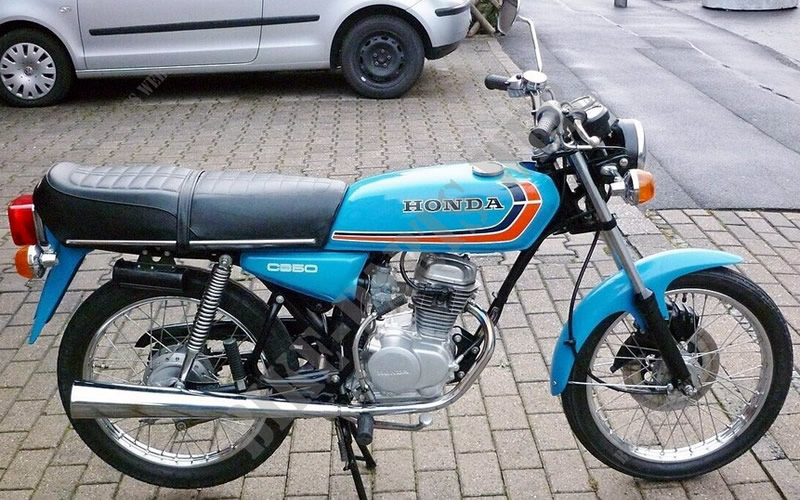
CB50, 1978 year, right view

CB125S, 1974 year, left view
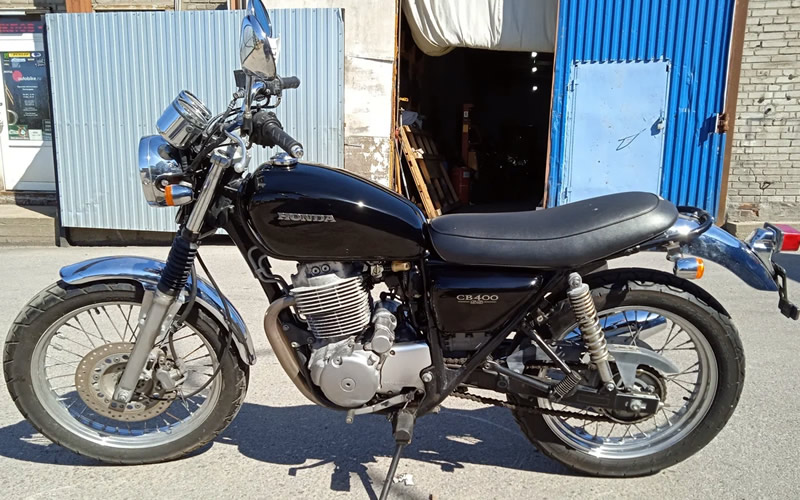
CB400SS, 2004 year, left view
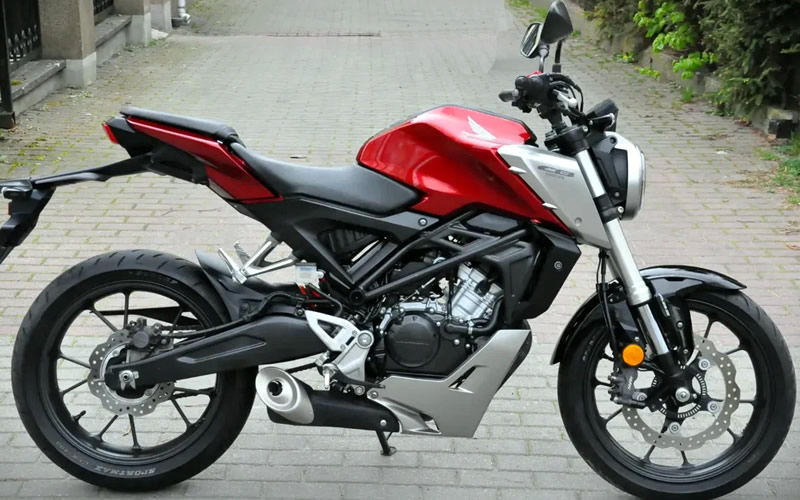
CB125R, 2020 year, right view
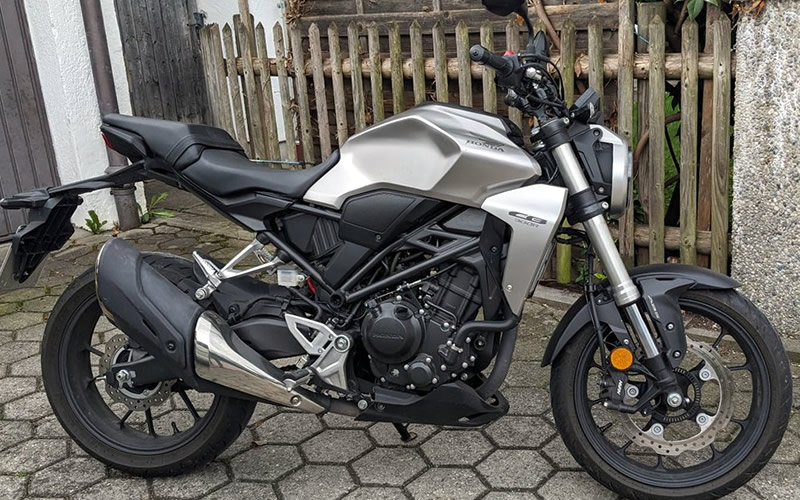
CB300R, 2018 year, right view
Twin-Cylinder CB Models
The first Honda CB models are twin-cylinder. They form the core of the brand's offering during the 1960s and then coexist with the four-cylinder CBs during the 1970s. The twin-cylinder CBs disappeared from the Honda catalog in 1982, only to reappear ten years later with the CB 500. In the early 2020s, Honda offers several twin-cylinder CB models: CB 500 F, CB 500 R, CB 500 X, or even CB 750 Hornet.
- CB 71 (1959)
- CB 72 (1960-1966): 247 cc/24 hp, 4-speed manual transmission, two carburetors; known in the United States as Hawk
- CB 77 (1962-1967): 305 cc/28.5 hp, 4-speed manual transmission, two carburetors; called Super Hawk in the United States and Super Sport in Europe
- CB 92 (1959-1965): 125 cc/15 hp, 4-speed manual transmission; power increased to 20 hp in racing version
- CB 125 K1 to K5 (1966-1974): 125 cc/15 hp, 5-speed manual transmission
- CB 125 T (1977-1988): 125 cc/16 hp, 5-speed manual transmission
- CB 160 (1961-1966): 161 cc/16.5 hp, 4-speed manual transmission, two carburetors
- CB 175 (1967-1973): 174 cc/20 hp, 4-speed manual transmission, two carburetors
- CB 200 (1973-1976): 198 cc/18 hp, 5-speed manual transmission, two carburetors
- CB 250 K1 to K4 (1968-?): 249 cc/30 hp, 5-speed manual transmission, two carburetors
- CB 250 G (1975): 249 cc/28 hp, 6-speed manual transmission, two carburetors
- CB 250 N Super Dream (1978-1986): 249 cc/27 hp, 6-speed manual transmission, two carburetors
- CB 250 T Dream (1977-1981): 249 cc/27 hp, 5-speed manual transmission, two carburetors
- CB 350 K1 to K4 (1968-1973): 326 cc/36 hp, 5-speed manual transmission, two carburetors
- CB 360 G (1974-1975): 357 cc/34 hp, 6-speed manual transmission, two carburetors
- CB 400 A Hondamatic (1978-1981): version of CB 400 T with two-speed automatic transmission
- CB 400 N Super Dream (1978-1986): 395 cc/43 hp, six valves, 6-speed manual transmission, two carburetors
- CB 400 T (1977-1981): 395 cc/40 hp, six valves, 5-speed manual transmission, two carburetors
- CB 450 K0 to K5 (1965-1974): 445 cc/43 hp, 4-speed manual transmission, two carburetors; sometimes nicknamed «Black Bomber»
- CB 500 (1993-1999): 499 cc/58 hp, 6-speed manual transmission, two carburetors
- CB 500 T (1975-1978): 498 cc/34 hp, 5-speed manual transmission, two carburetors
- CB 750 Hornet (2023-): 755 cc/92 hp, 6-speed manual transmission, fuel injection
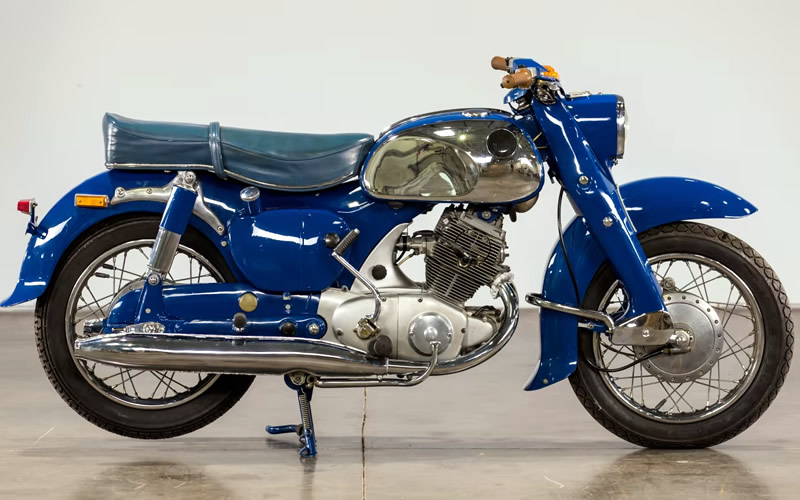
C71, 1959 year, right view
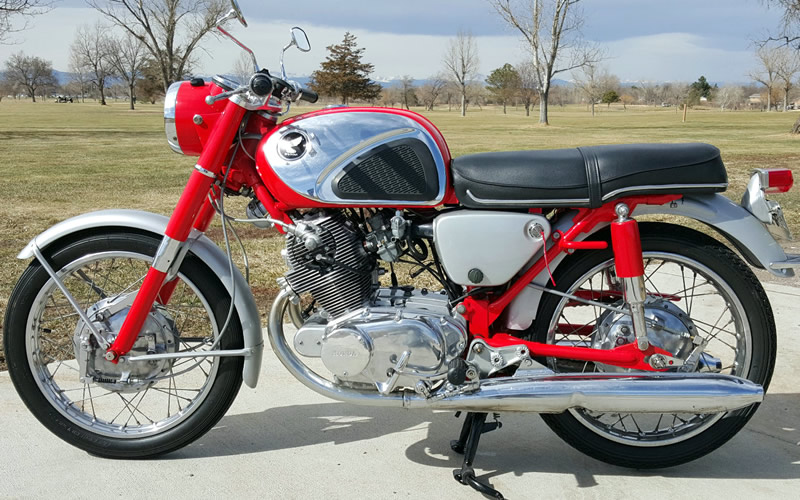
CB77, 1965 year, left view

CB125T, 1983 year, right view
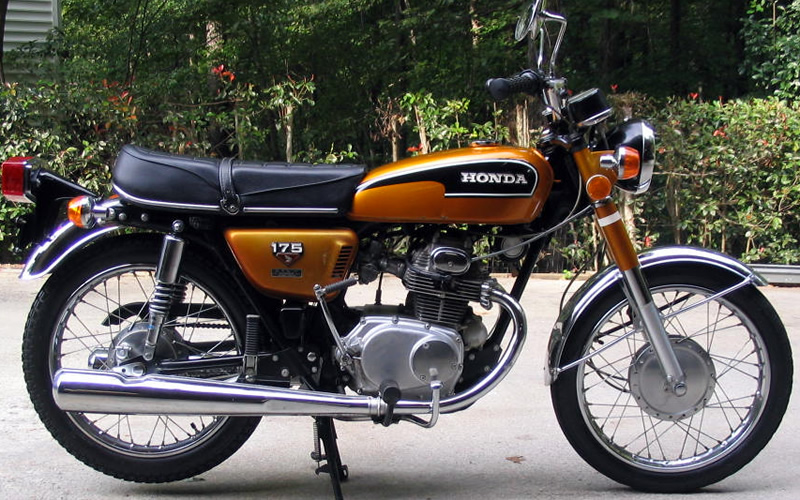
CB175, 1970 year, right view
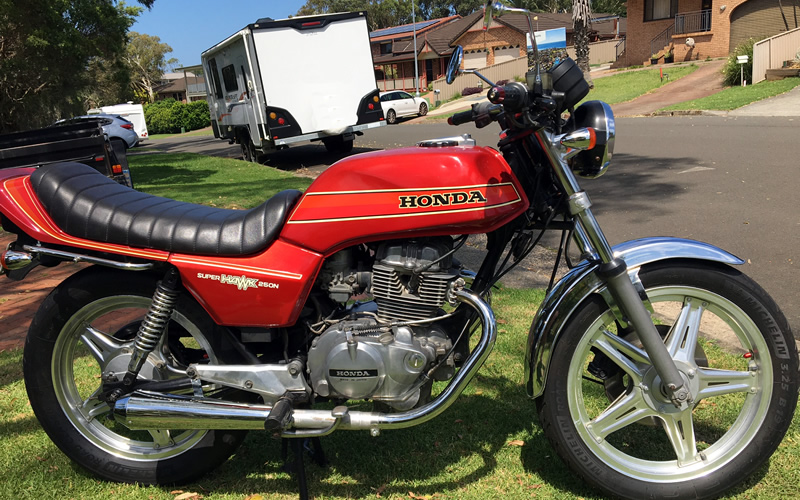
CB250N, 1980 year, right view
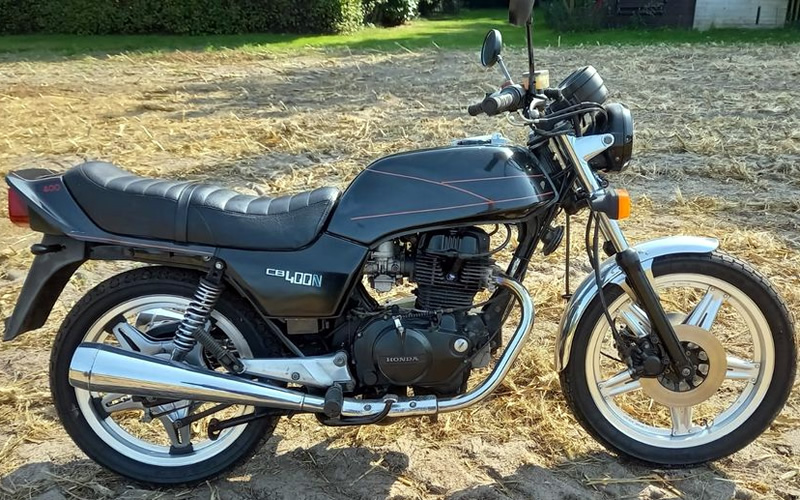
CB400N, 1981 year, right view
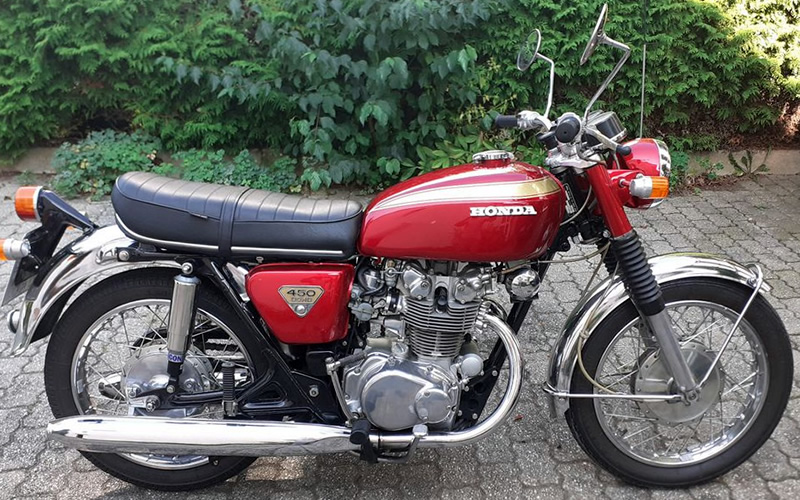
CB450K1, 1971 year, right view
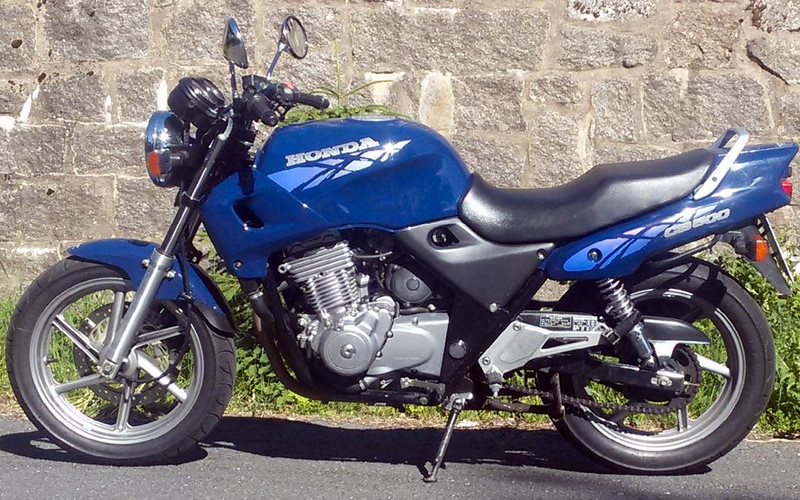
CB500, 1995 year, left view
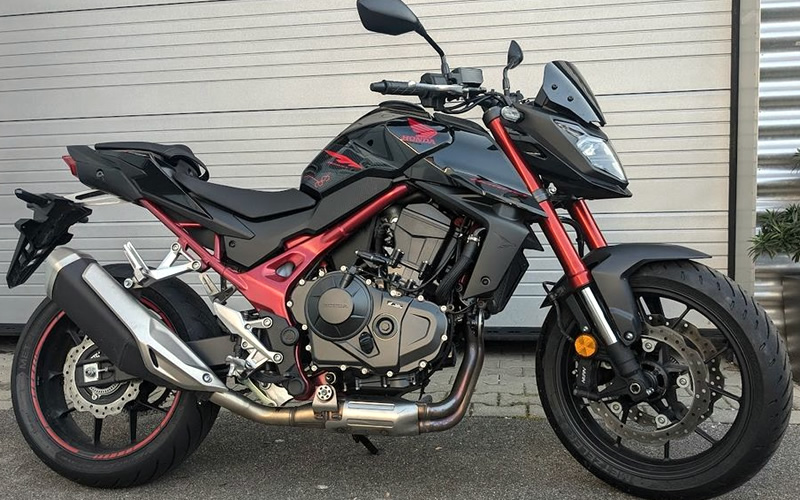
CB 750 Hornet, 2023 year, right view
Four-Cylinder CB Models
The first of the four-cylinder CBs is the very famous CB 750 Four, which appeared in 1969. With its complete equipment, quality of manufacture, performance, and reliability, the CB 750 Four had a significant impact on the global market and on Honda's competitors. Some historians consider it the «motorcycle of the century» or the first motorcycle of the modern era. Honda has continuously offered four-cylinder CBs since 1969, with displacements ranging from 350 to 1300 cc.
- CB 350 F (1972-1974): 347 cc/32 hp, 5-speed manual transmission, four carburetors
- CB 400 F (1974-1977): 409 cc/37 hp, 6-speed manual transmission, four carburetors
- CB 400 SF (Super Four) (1992-2022): 399 cc/56 hp, 6-speed manual transmission
- CB 500 (1971-1975): 498 cc/50 hp, 5-speed manual transmission, four carburetors
- CB 500 F (2013-2015): 471 cc/48 hp, 6-speed manual transmission, fuel injection
- CB 550 F1, F2 and K1, K2, K3 (1974-1979): 544 cc/50 hp, 5-speed manual transmission, four carburetors
- CB 600 F Hornet (1998-2002): 599 cc/96 hp, 6-speed manual transmission, four carburetors
- CB 650 F (1979-1982): 626 cc/63 hp, 5-speed manual transmission, four carburetors
- CB 650 F (2014-2016): 649 cc/87 hp, 6-speed manual transmission, fuel injection
- CB 650 R (2019-): 649 cc/95 hp, 6-speed manual transmission, fuel injection
- CB 750 A Hondamatic (1975-1978): 736 cc/47 hp, automatic transmission, four carburetors
- CB 750 Four K0 to K8 and F1 to F4 (1969-1977): 736 cc/67 hp, 5-speed manual transmission, four carburetors
- CB 750 SC Nighthawk (1982-): 749 cc/70 hp, 5-speed manual transmission, four carburetors
- CB 750 Seven Fifty (1992-2001): 747 cc/74 hp, 5-speed manual transmission, four carburetors
- CB 900 C (1980-1982): 901 cc/95 hp, 5-speed manual transmission, four carburetors
- CB 900 F Hornet (1998-): 919 cc/106 hp, 6-speed manual transmission, fuel injection
- CB 900 F Golden Bowl (1979-1980): 901 cc/95 hp, 5-speed manual transmission, four carburetors
- CB 1000 (1992-1998): 998 cc/98 hp, 6-speed manual transmission, four carburetors, sometimes called «Big One»
- CB 1000 R (2008-2017): 998 cc/125 hp, 6-speed manual transmission, fuel injection
- CB 1100 EX (2014-2019): 1140 cc/89 hp, 6-speed manual transmission, fuel injection
- CB 1100 F Super Golden Bowl (1981-1983): 1062 cc/110 hp, 5-speed manual transmission, four carburetors
- CB 1100 R (1981-1983): 1062 cc/115 hp, 5-speed manual transmission, four carburetors
- CB 1100 SF X11 (1999-2002): 1137 cc/136 hp, 5-speed manual transmission, fuel injection, also called «X-eleven»
- CB 1300 Super Four (1998-2006): 1284 cc/100 hp, 5-speed manual transmission, fuel injection
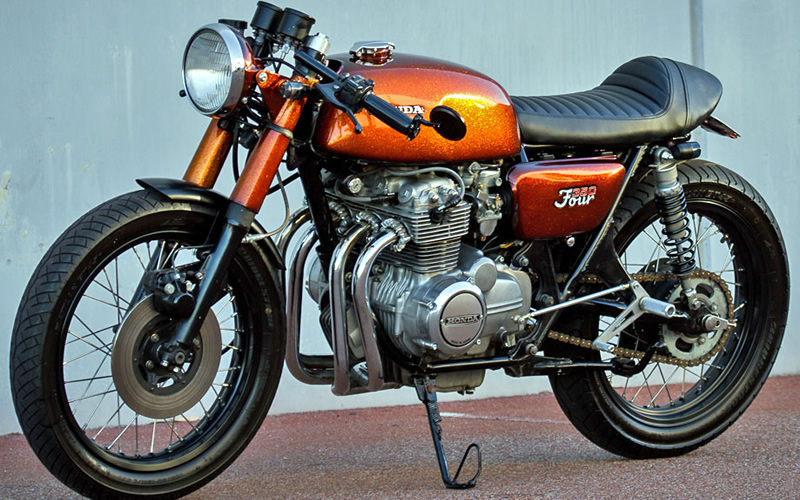
CB350F, 1973 year, left view
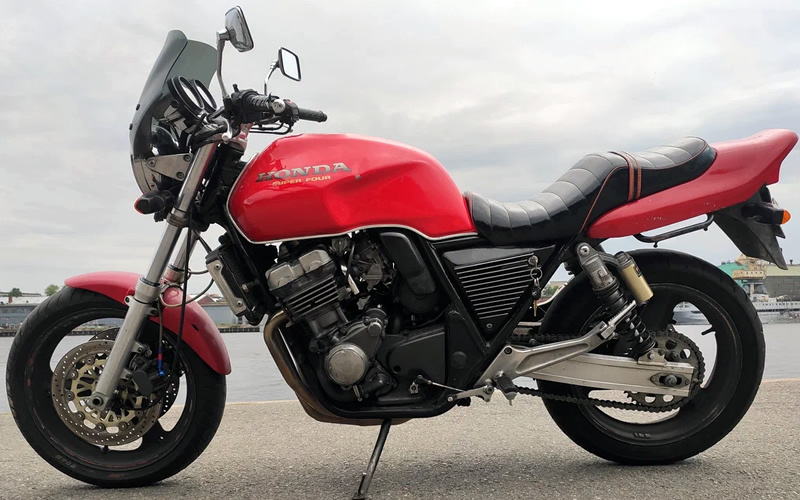
CB400SF, 1996 year, left view
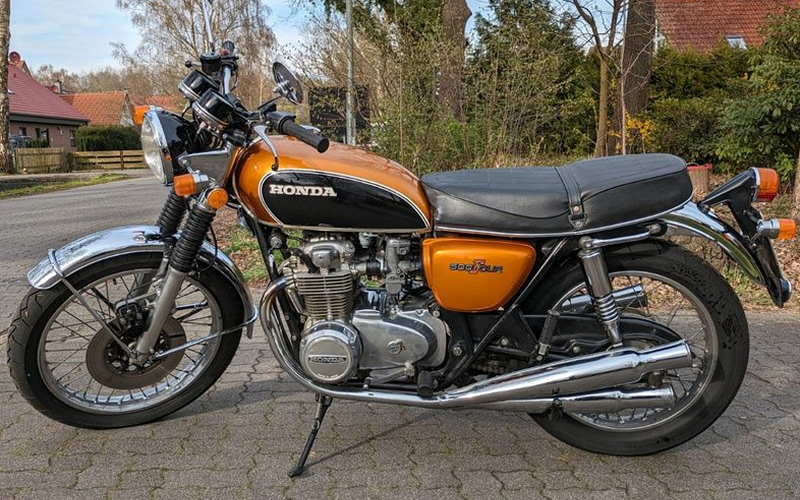
CB500 Four, 1973 year, left view
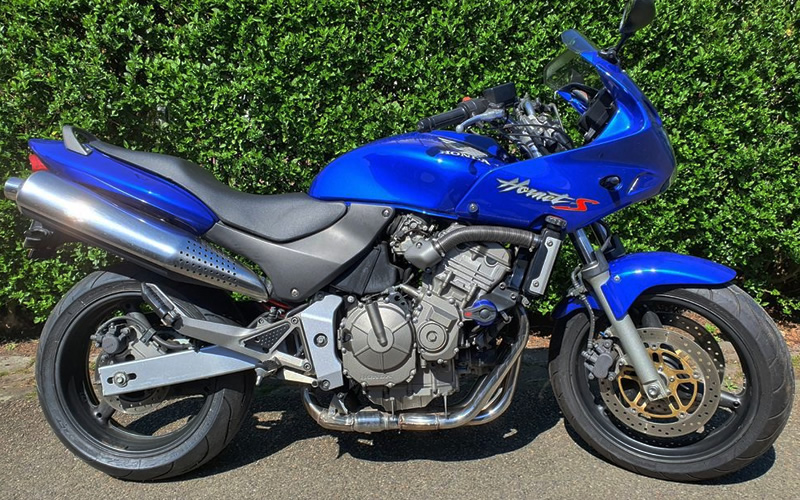
CB600F Hornet, 1999 year, right view
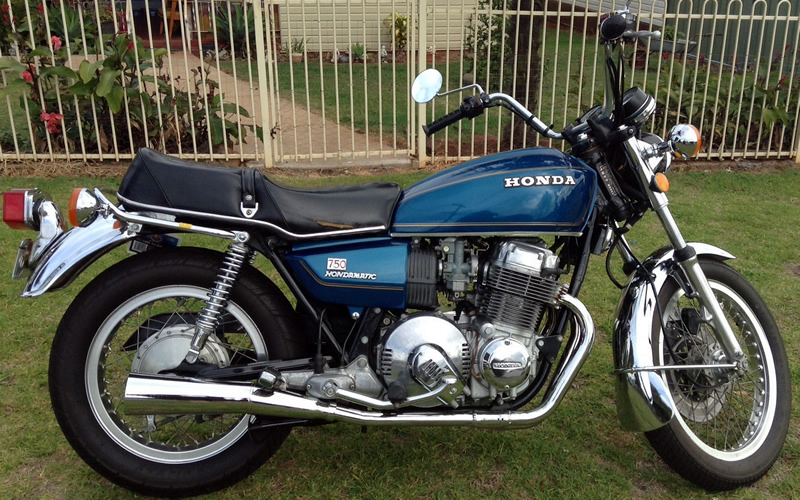
CB750A Hondamatic, 1977 year, right view
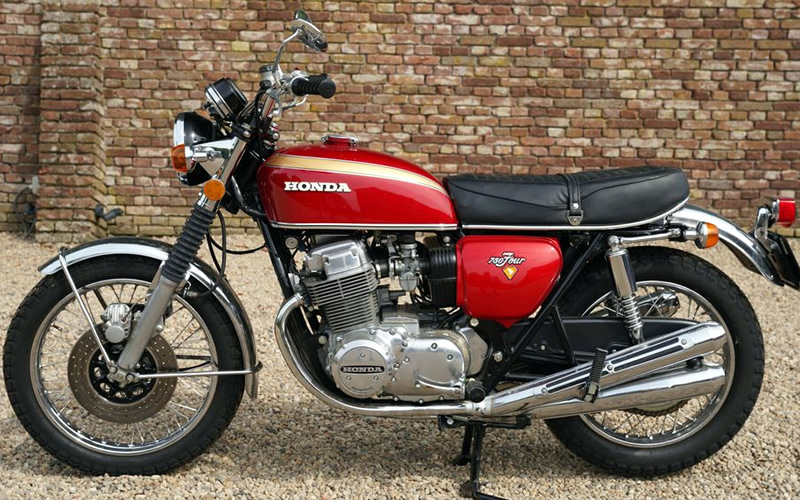
CB750 Four K2, 1974 year, left view
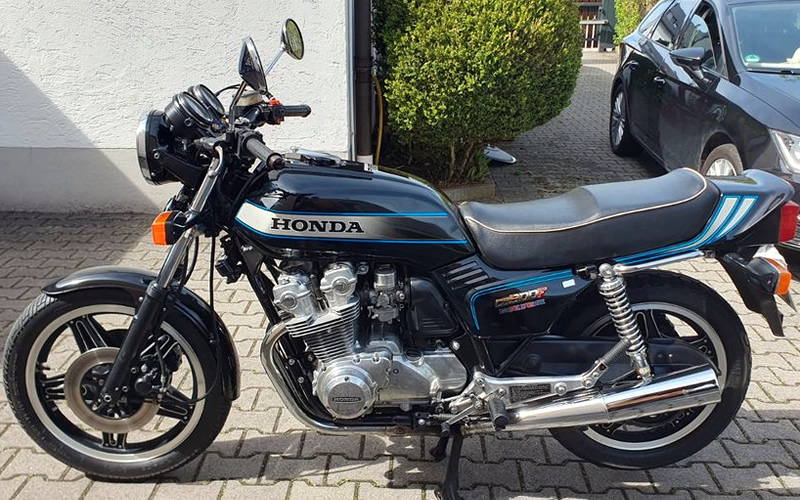
CB900C, 1980 year, left view
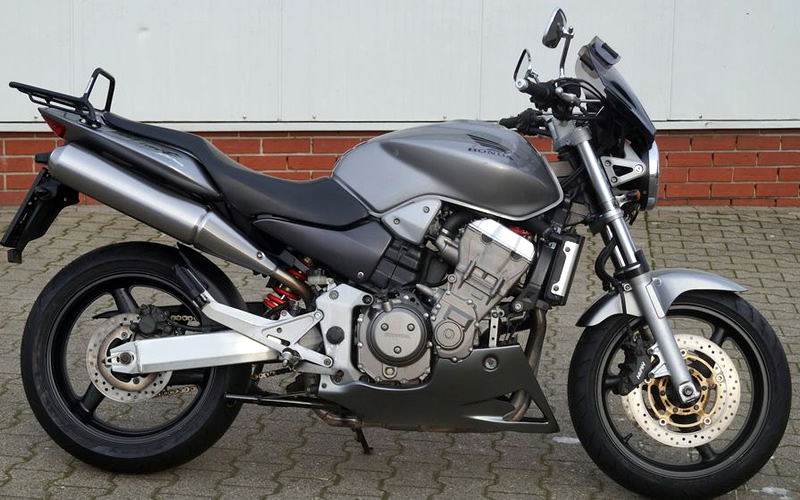
CB900F Hornet, 2002 year, right view
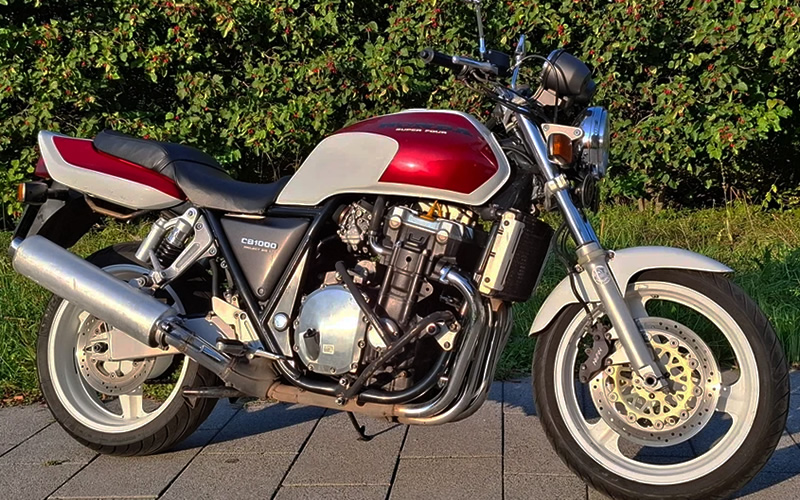
CB1000, 1993 year, right view
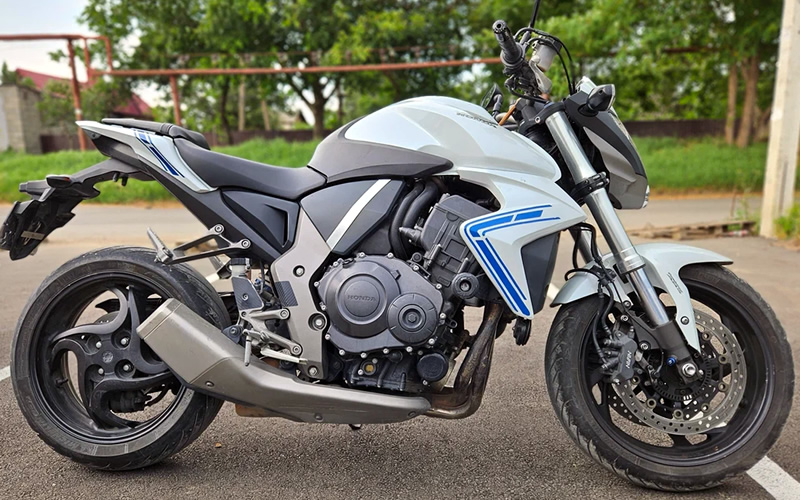
CB1000R, 2009 year, right view
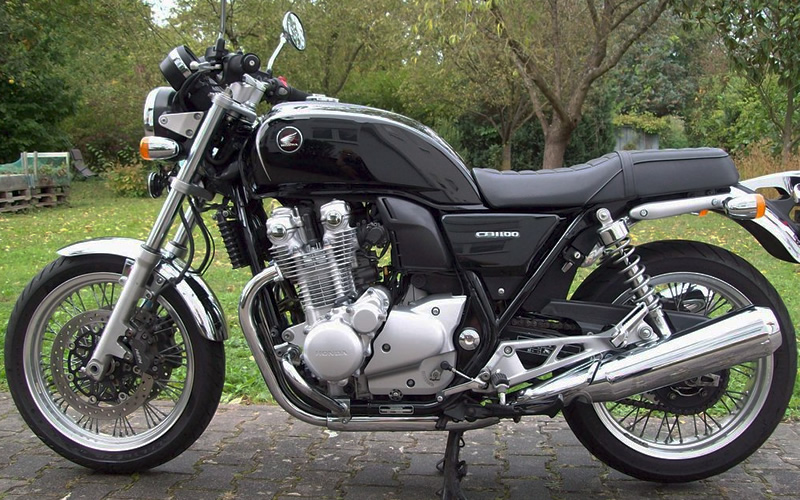
CB1100EX, 2015 year, left view
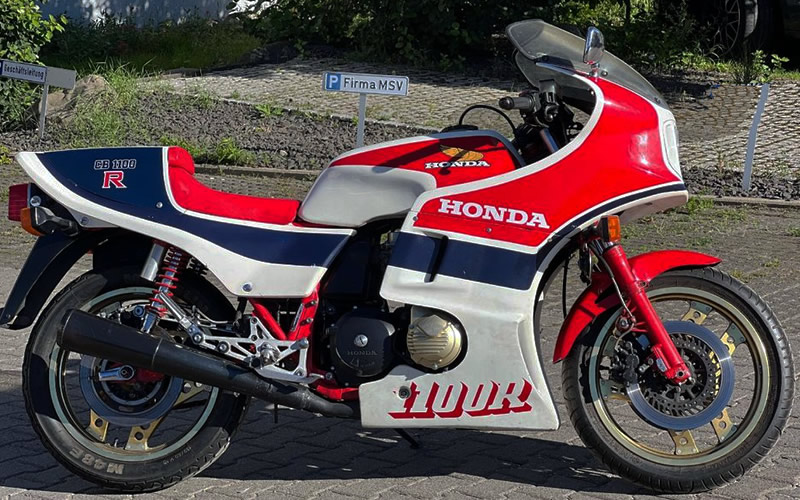
CB1100R, 1982 year, right view

CB1100SF (X11), 2001 year, right view
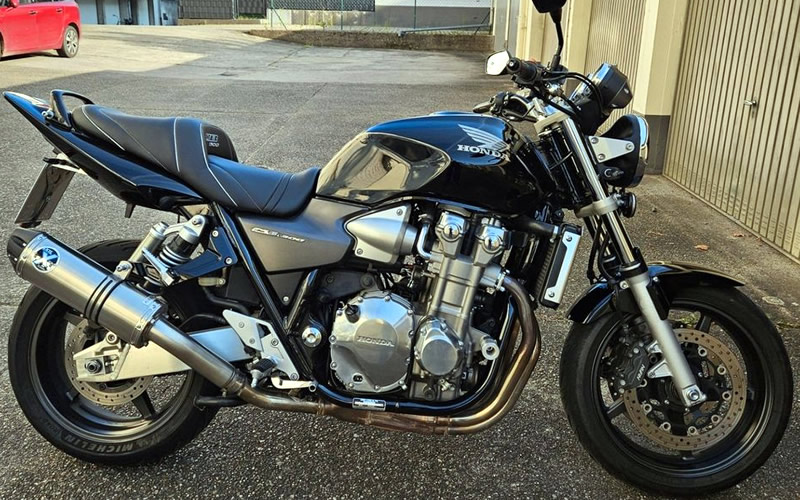
CB1300 Super Four, 2004 year, right view
- Information for owner
- Operation manual
- Maintenance
- Engine and systems
- Engine repair
- Lube system
- Cooling system
- Fuel and exhaust system
- Transmission
- Running gear and frame
- Wheels and tires
- Front suspension and handlebar
- Rear suspension
- Brake system
- Frame and hinged elements
- Electric equipment
- Equipment and devices
- Ignition system
- Starting and charging system
- Lighting and alarm
- Electrical circuits
